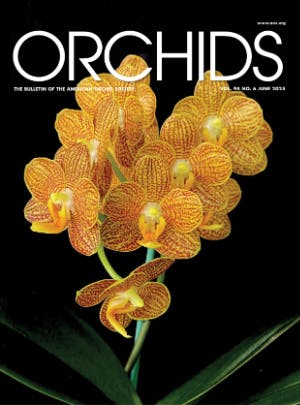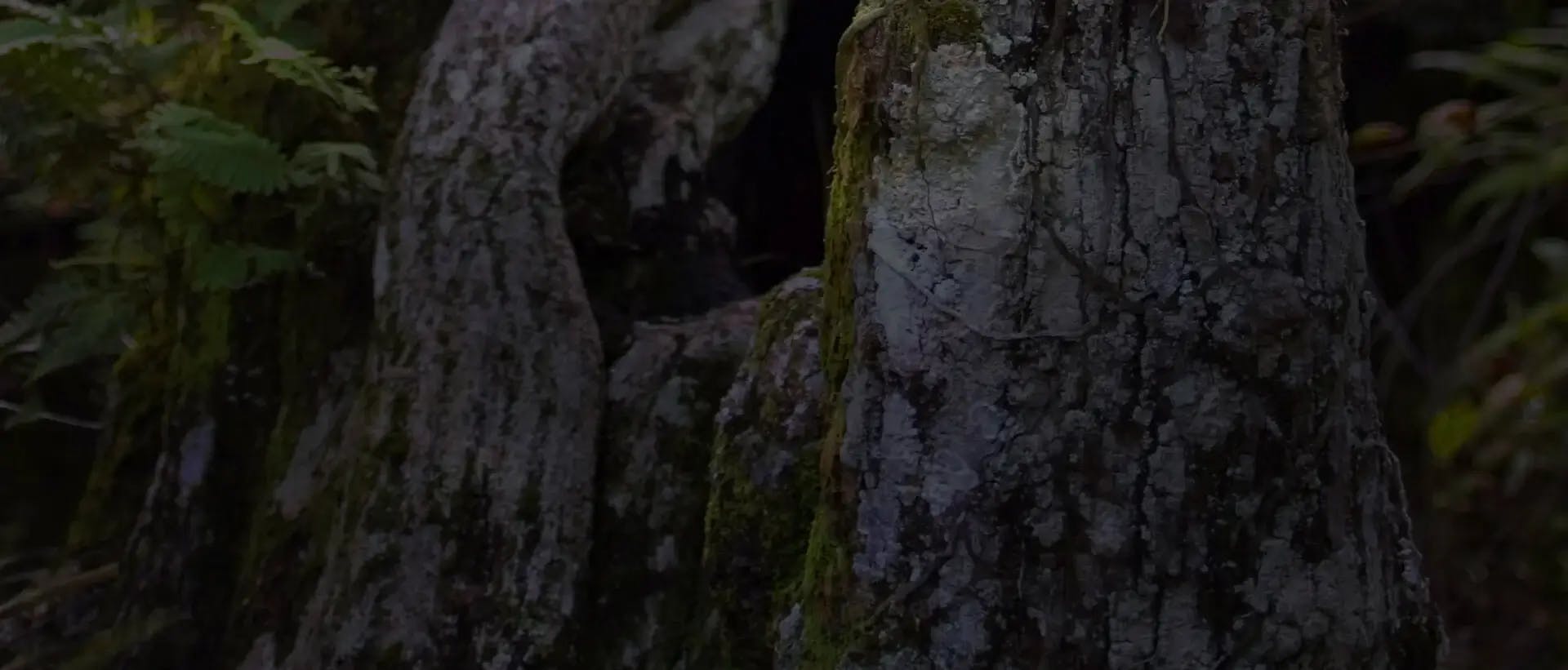
PHALAENOPSIS ARE EASY to grow and they bloom and bloom, some for more than three months at a time. They enjoy bright, shady conditions and a somewhat water-retentive growing medium. They are sensitive to the cold, so they may need a winter home indoors; an eastern window is ideal. Finding a location outdoors in the summer months where they are exposed to loads of fresh air and the day–night temperature change will pay big dividends when it comes time for them to bloom. Just be careful to have them in a location where water cannot collect in the crown of the plant, causing rot. A covered porch or pergola is an ideal place to summer your phals.
So, if they are so easy to grow, what can go wrong? I have had my share of maladies, from cultural errors to pests and diseases, and have also received pictures of Phalaenopsis problems that other growers have shared, some of which are reproduced herein.
WITH CULTURE You know you must balance the amount of water, light, air and the other cultural factors your orchid receives, but everyone makes cultural errors from time to time. Improper watering can create a variety of problems for you, as can insufficient air movement or extremes of temperature. Cultural errors may very well cause more problems than those from orchid pests and diseases.
Crown Rot If water is allowed to stand in the crown of your plant, naturally occurring bacteria will proliferate, which can cause the growing tip of the plant to rot. This is a major concern for outdoor growers who do not have an overhang or cover to prevent water from accumulating. Normal watering can also cause water to pool in the crown. Tilt the plant to allow water to drain from the crown or position the plant so the crown will naturally drain any accumulated water, or add a few drops of hydrogen peroxide to the crown to kill any bacteria. You hope that the plant will sprout a new plantlet from below the damaged crown.
CROWN ROT FROM WATER ACCUMULATING IN THE CROWN OF THE PLANT
[1] Phalaenopsis grow upward from a central stem. If the growing tip rots from water standing in the crown, the plant cannot grow replacement leaves.

[2] If the plant has sufficient energy reserves, it may be able to sprout a new plantlet from the base of the plant below the damaged tissue.

Edema Edema is caused when your plant absorbs more water than can be shed from the leaves, so the plant cells swell and produce a blister-like lesion. It typically occurs when watering late in the day on a day when the night turns cool. During the cooler months, it is important to follow the much-repeated advice to water early in the day.
EDEMA — BLISTER-LIKE LESIONS FROM WATERING LATE WHEN NIGHTS ARE COOL
[3] You can see water-filled blisters in the early stage of Edema (the blue spotting is residual from spraying a copper fungicide).

[4] The damaged tissue can become tan to brownish and corky over time and trick you into thinking it is some sort of scale infestation.

Root Rot The roots of your phalaenopsis can rot either because they are being watered too frequently or because the potting mix is breaking down, which is a nicer way of saying your potting mix is rotting. If the mix begins to rot, your roots will likewise begin to rot. You may also find a white filamentous snow mold growing in the decaying mix. The snow mold is water-repellent, so once it covers the roots, they cannot absorb water. If your plant starts to look dehydrated, it probably is dehydrated. Knock it out of the pot and find out why.
ROOT ROT — OVERWATERING OR DECAYING POTTING MIX
[7] Your Phalaenopsis leaves should be plump and turgid. These leaves have become thin and droopy because the roots rotted and could not absorb water.

[8] Repot your plant in fresh potting mix and water lightly until it reestablishes. This is the same plant three months later.

[9] Snow mold also grows in decaying potting mix and can suffocate the roots. Wash off the old potting mix and repot in fresh mix.

Sunburn The sudden appearance of black spots can be caused by sunburn, a result of leaves becoming overheated from too much light, such as from a sudden increase in light during a change in seasons or moving plants outdoors in the spring. The burn occurs on the highest point of the leaf where it is exposed to the most sun. The burn fades to a thin tan-colored leaf scar over time and can be invaded by secondary infections. If the damage is not too severe, it is unsightly, but the leaf will still photosynthesize. You may want to remove severely damaged leaves.
Cold Damage Cold damage can occur from exposure to low temperatures or watering with cold water. Cold damage causes the collapse of cell tissue, resulting in surface lesions, pitting, sunken areas and discoloration. The tissue can become watersoaked, wilted and browned, and can be susceptible to secondary infection. Know the temperature requirements of your orchids and watch the projected nighttime lows during winter. Use room-temperature water for your orchids and save your ice cubes for your evening toddies. Remove severely damaged leaves.
TEMPERATURE EFFECTS — SUNBURN AND COLD DAMAGE
[5] Sunburn is a thermal effect that begins as a whitish or yellowish scar fading to tan or black depending on the severity of the burn.

[6] Cold damage can occur from low temperatures, watering with cold water or using ice cubes.

PROBLEMS WITH PESTS Mealybugs, scale and mites are the most common enemies of your phalaenopsis.
Mealybugs and Scale Although they have different appearances, the damage they cause and their treatment are the same. Mealybugs appear to be white cottony masses that can occur on any part of the plant from the roots to the flowers, though they tend to hide in plant crevices. There are different types of scale, but the kinds that typically infest phalaenopsis are soft brown scale, which forms light yellowish to dark brown oval to circular shells, and armored scale, which ultimately forms a brown conical structure protecting the juvenile scale underneath it. Scale can appear on leaves, flowers, flower spikes and sometimes roots. Soft scale produces honeydew, but hard scale does not.
If there are only a few scale or mealybugs, use a cotton swab dipped in isopropyl alcohol to remove the pests physically, or put the alcohol in a spray bottle and spray all visible pests and hiding places. For more severe infestations, use repeat applications of a contact pesticide or use the homemade remedy of one part isopropyl alcohol, one part Formula 409 all-purpose cleaner or Murphy’s Oil Soap and two parts water. Be sure to spray all plant surfaces and pest hiding places. Drenches, in which the insecticide is poured through the potting mix, are easier to apply than contact pesticides and probably more effective, with the added benefit of lowering your potential exposure to chemicals. If available where you live, you can apply one of the commercially available products containing the active ingredient imidacloprid; the orchid will move the chemical through the roots into the leaves and kill the pests from the inside out. Always follow the manufacturer’s instructions concerning dilution rates.
MEALYBUGS AND SCALE
[10] Soft brown scale may appear on leaves, flowers and flower stems. You may notice a sticky saplike substance.

[11] Armored scale have a hard, crusty coating protecting the scale underneath, but they can easily be removed with a cotton swab or soft toothbrush.

[12] Mealybugs look like white cottony masses that may appear on your leaves, though they love to hide in plant crevices.

[13] Mealybugs (and even scale) are also happy feasting on your roots, out of sight. You may have to pour an insecticide drench through the potting mix for really effective control.

Mites Mites are not insects; they are members of the spider or arachnid family. There are three groups of mites infesting cultivated orchids: spider mites, flat mites and broad mites. The twospotted red spider mite (Tetranychidae) causes a chlorotic spot or stipple at each feeding site as chloroplasts are sucked out along with the plant sap. Leaves eventually develop a mottled or stippled appearance, with webbing under the leaf in severe infestations. Flat mites, or false spider mites (Tenuipalpidae), including the Phalaenopsis mite, often feed on the upper surfaces of leaves, creating a pockmarked appearance from empty and collapsed leaf cells. Broad mites (Tarsonemidae) are microscopic, and the initial symptom is chlorotic discoloration.
Mites proliferate during warm, dry conditions and are often pests on indoor phalaenopsis. To prevent or treat for mites, spray upper and lower leaf surfaces with the home-cure mixture of one part rubbing alcohol, one part Formula 409 or Murphy’s Oil Soap and two parts water. Plants can also be sprayed with a miticide such as Avid, Talstar or Kelthane, following label instructions and being particularly careful to contact all the undersides of the leaves. During warm weather, new generations mature every six days, so repeat applications will be required.
MITE DAMAGE ON PHALAENOPSIS
[14] Damage from red spider mites includes stippling and webbing on the underside of the leaf.

[15] Damage from flat mites includes pockmarking on the upper leaf surface and no webbing.

PROBLEMS WITH DISEASE There are some diseases to which phalaenopsis are susceptible, including bacterial soft rot, bacterial brown spot, collar rot and botrytis.
Bacterial Infections With bacterial soft rot, small water-soaked spots appear on the leaves and often are surrounded by yellow halos. If unchecked, the infection spreads so rapidly that plants may be completely rotted in two to three days. This wet rot may have a foul odor and has a water-soaked appearance. Bacterial brown spot is the most common disease of Phalaenopsis. The symptoms may appear anywhere on the leaf as a small, soft, watersoaked blister that may be surrounded by a yellowish or pale green halo. Initially, dirty green in color, spots coalesce and enlarge, and eventually become brown or black, dried up and sunken. If the diseased area invades the crown, the plant will die.
For fast-moving soft rots, immediately remove infected tissue about an inch (0.4 cm) below the affected tissue using a sterile instrument, then pour peroxide over the wound. For bacterial brown spot, pour peroxide over the infected tissue, and if it continues to enlarge, consider removing the infected tissue. Bactericides such as Physan 20 or copper compounds can be sprayed on infected and adjacent plants following label instructions (copper should not be used on dendrobiums or blooming plants). Treat nearby plants as well as those that are diseased.
PHALAENOPSIS DISEASES — BACTERIAL AND FUNGAL PROBLEMS
[16] Bacterial Soft Rot caused by Erwinia

[17] Bacterial Brown Spot caused by Pseudomonas

[18] Collar Rot or Southern Blight caused by Sclerotium

[19] Flower blighting caused by Botrytis

Collar Rot The main symptom of southern blight or collar rot is a rapid collapse and rotting of the roots, stem and lower parts of the leaves. The base of the stem turns creamy yellow, later dark brown, and the infection spreads to the roots and leaves. The disease eventually girdles and destroys the entire basal portion of the plant. Small yellow or tan sclerotia resembling mustard seeds form on the affected tissue. You can treat the plant with a systemic fungicide containing thiophanate methyl (such as Thiomyl, Cleary’s 3336 or Banrot) and perhaps save the plant if the disease has not progressed too far. Sterilize benches and surrounding area with bleach, Physan 20 or pool algaecide.
Botrytis This is a fungal infection that causes very small black or light brown spots on the flowers. The spots may enlarge andcover the entire flower. If conditions are moist, a gray fungal growth may appear on severely infected or decaying flowers. This fungus is common in the environment and cannot be eradicated. Remove infected flowers because these are reservoirs of infection. Infection may be reduced through careful sanitation, increased air circulation, reduced humidity and warmer night temperatures (above the mid-60s F [17–18 C]). You can spray with a protectant fungicide such as Daconil or the home remedy of baking soda at 2 teaspoons per gallon (2.6 ml/liter).
PROBLEMS WITH VIRUS Virus expresses itself in chlorotic and necrotic spots, streaks, lines and rings in the leaves. Flowers may show necrotic spots and streaks as well as color break, often resulting in an unhealthy, ugly-looking plant. The virus, if present, is present in all parts of the plant. There is no treatment for a virus-infected plant. Destroy the plant to prevent it from infecting other plants. If the plant is valuable, isolate it completely from other plants and follow strict precautions to prevent infecting other plants.
VIRUSED PHALAENOPSIS
[20] This Phalaenopsis suffers from “ugly plant syndrome” as a result of a virus, confirmed by the Agdia test strip.

[21] The presence of so-called color-break in Phalaenopsis flowers is not always a good indicator of a virus. This virus-infected Phalaenopsis has chlorotic streaking and spotting, although there is no color break in the flower.

[22] A very faint chlorotic streaking in the leaf is an early warning that the plant may be virus-infected.

PROBLEMS WITH DEFORMITIES Sometimes, problems can arise for no obvious reason. An inflorescence can emerge from the central growing tip of the plant, called an apical spike, rather than from under the leaves. This may mean the plant will no longer produce new leaves from the growing tip, and you may have to wait for a basal keiki to form for the plant to continue growing. The inflorescence can also get twisted under the leaf and even start growing through a leaf in its attempt to grow toward the sunlight. I have broken many inflorescences trying to straighten
them. If you do not catch it early enough to gently reorient the spike, it may be better to let it find its own way. You may also get leaf deformities, which may indicate a genetic defect, a reaction to chemicals applied or just a random mutation that will be followed by normal plant growth.
WHAT THE…?
[23] This Phalaenopsis plant has a normal flower spike to the right and an apical spike emerging from the growing center of the plant.

[24] This flower spike got disoriented as it tried to emerge and became twisted under the leaf as it sought light.

[25] This leaf seems to have mutated — growing into a funnel shape. Plants that do this will often go on to produce other normal leaves.

SEASONAL CARE In the spring, once nighttime temperatures stay about 60 F (15.5 C), move your phalaenopsis to its shady summer home. During the summer, your plant will gather its strength for next year’s blooms. Water with a dilute fertilizer solution when the potting mix approaches dryness. When the temperatures first start to cool in the fall, leave the plant outdoors to receive a chill as long as temperatures do not drop below 50–55 F (10–12.8 C). This signals the plant to start the bloom cycle. After two or three weeks or when the temperatures drop below 50 F (10 C), bring the plant indoors for the winter. Continue watering with a dilute fertilizer solution when the potting mix approaches dryness. You should see flower spikes by Christmas and flowers by Valentine’s Day. By Independence Day, you will remove the spent flower spike and decide whether your plant needs to be repotted; this is normally needed every year or two.
WHEN ALL GOES WELL
[26] Phalaenopsis Medellin Spring (Brother Love Rosa × Little Gem Stripes) blooming in profusion.

Finding the right spot to grow your phalaenopsis will prevent many diseases and environmental problems from developing. A bright, shady spot with fresh air bathing your plant will help keep
it healthy. Observe your plant to make sure the leaves are plump and green, and react to problems quickly. Then kick back and enjoy the blooms!
Acknowledgments
Thanks to all who sent pictures of your plants to info@staugorchidsociety.org so that we could help with the diagnosis and suggestions for treatment.
— Sue Bottom started growing orchids in Houston in the mid-1990s after her husband Terry built her first greenhouse. They settled into St. Augustine, Florida, Sue with her orchids and Terry with his camera, and are active in the St. Augustine Orchid Society, maintaining the society’s website and publishing its monthly newsletter. Sue is also a member of the AOS Editorial Board (email sbottom15@hotmail.com).












